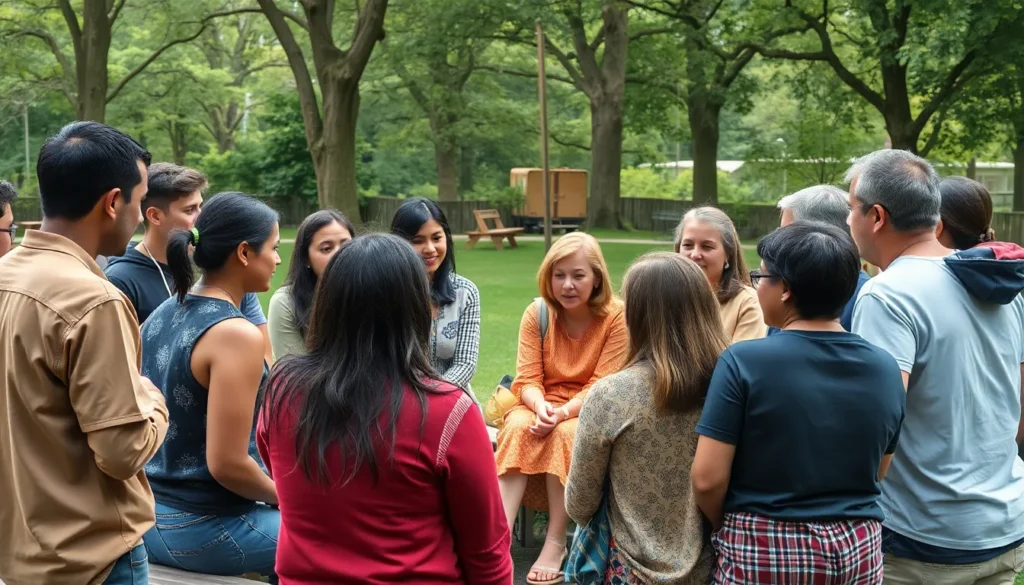Table of Contents
ToggleWhen it comes to conflict, most people think of heated arguments and dramatic standoffs. But what if there’s a way to turn those fiery exchanges into opportunities for growth? Enter conflict transformation, the superhero of dispute resolution. Instead of merely putting out fires, it dives deep into the heart of the matter, aiming to reshape relationships and foster understanding.
Understanding Conflict Transformation
Conflict transformation represents more than resolving disputes; it involves altering relationships and fostering deeper understanding. This approach considers the potential benefits of conflict as opportunities for growth.
Definition and Key Concepts
Conflict transformation refers to a process designed to change the dynamics and structures underlying conflicts. It differs from conflict resolution by aiming not just to resolve issues but to change attitudes and relationships that provoke conflict. Key concepts include relational changes, addressing root causes, and emphasizing constructive dialogue. This approach encourages stakeholders to engage in transformative practices that lead to lasting peace.
Historical Context
Conflict transformation emerged as a distinct field in the late 20th century. Scholars and practitioners recognized conventional approaches often failed to address underlying issues. Influenced by peace studies and social change theories, figures like John Paul Lederach popularized the concept. These contributions highlighted the importance of addressing systemic factors involved in conflicts, paving the way for innovative practices in peacebuilding and reconciliation.
The Process of Conflict Transformation

Conflict transformation encompasses several phases, each essential for reshaping relationships and fostering mutual understanding.
Phases of Transformation
Identifying the initial signs of conflict marks the first phase. Understanding root causes follows. Throughout this phase, stakeholders assess underlying issues, recognizing the need for dialogue. Facilitating open communication constitutes the next phase. Transformative practices emerge during discussions, encouraging collaboration and empathy. Implementing changes represents the final phase. Stakeholders work on solidifying new relationships and structures, ensuring stability and growth. Each phase builds on the previous one, ultimately leading to a constructive resolution.
Roles of Stakeholders
Active participation by stakeholders is crucial for effective conflict transformation. Leaders often guide the process, providing vision and direction. Mediators play a pivotal role, facilitating communication among parties and fostering trust. Community members can contribute by sharing perspectives and experiences, enriching discussions. Additionally, external actors, such as NGOs, may offer resources or expertise, supporting local efforts. Emphasizing their roles enhances the likelihood of lasting change, as collaborative engagement fosters a deeper understanding of conflicts. Each stakeholder’s input significantly contributes to transforming conflict dynamics.
Strategies for Effective Conflict Transformation
Effective conflict transformation relies on various strategies that enhance understanding and promote collaboration among stakeholders.
Dialogue and Communication
Open dialogue creates an environment where differing perspectives can surface and be explored. Focusing on active listening encourages participants to understand each other’s views more deeply. Structured conversations that allow for sharing feelings and needs can facilitate empathy. Engaging in face-to-face discussions is often more effective than written communication, as it fosters connection. Using neutral language helps prevent escalation, making it easier for individuals to express concerns without triggering defensiveness. Regular check-ins during the transformation process ensure that all participants feel heard and valued.
Building Trust and Relationships
Establishing trust is foundational to conflict transformation. Trust-building activities, such as team-building exercises, help establish rapport among participants. Sharing personal stories can humanize each side and strengthen relationships. Involving all stakeholders in decision-making processes promotes a sense of ownership and accountability. Consistency in actions generates reliability, making it easier for individuals to engage openly. Ensuring transparency in communications builds confidence among participants. A long-term commitment to relationship maintenance is essential for lasting peace, reinforcing the idea that conflict transformation is an ongoing journey, not a one-time event.
Challenges in Conflict Transformation
Conflict transformation faces various significant challenges that can hinder the process. These obstacles often stem from deep-rooted issues and complex dynamics among stakeholders.
Common Obstacles
Common obstacles include miscommunication and lack of trust. Misunderstandings can escalate tensions, while absence of trust can lead to reluctance in engaging. Emotional barriers often surface due to past grievances, making open dialogue difficult. Additionally, differing priorities among stakeholders can create friction, complicating the resolution process. Resource limitations such as funding and time constraints frequently impede efforts, reducing opportunities for meaningful engagement and constructive discussions.
Addressing Power Imbalances
Addressing power imbalances proves crucial for effective conflict transformation. Dominant voices often overshadow marginalized stakeholders, stifling diverse perspectives. This exclusion can perpetuate existing conflicts and inhibit genuine collaboration. Empowering underrepresented groups fosters inclusive discussions and encourages equitable participation. Implementing strategies such as mediation or third-party facilitation helps level the playing field, allowing all voices to be heard. Recognizing and actively mitigating power dynamics enhances the likelihood of reaching sustainable resolutions and transforms the conflict landscape positively.
Conflict transformation offers a dynamic approach to resolving disputes that prioritizes growth and understanding over mere resolution. By reshaping relationships and addressing root causes, it paves the way for deeper connections and lasting peace. This process requires active participation from all stakeholders and a commitment to open dialogue, trust-building, and inclusivity.
While challenges like miscommunication and power imbalances can arise, overcoming these obstacles is essential for effective transformation. Embracing the principles of conflict transformation not only leads to constructive resolutions but also fosters a culture of empathy and collaboration. Ultimately, it’s a journey that demands dedication and effort, but the potential rewards of harmonious relationships and sustainable peace make it a worthwhile endeavor.




